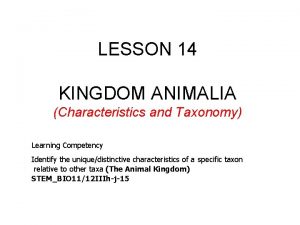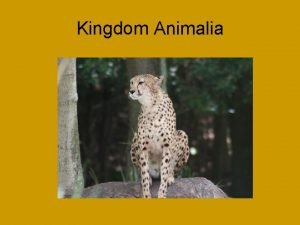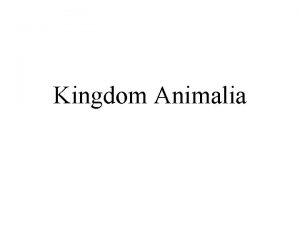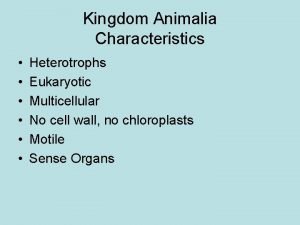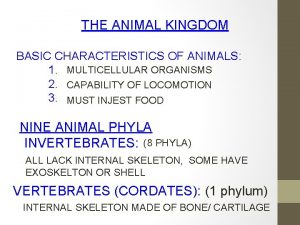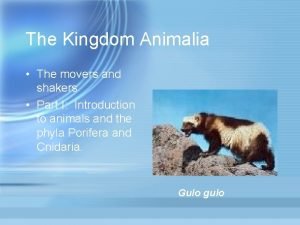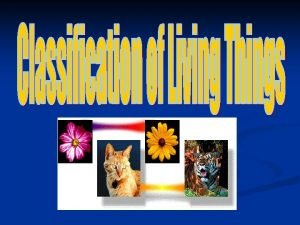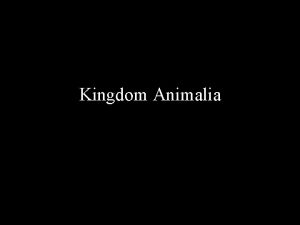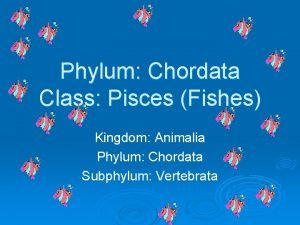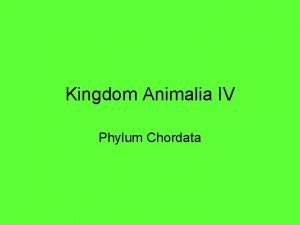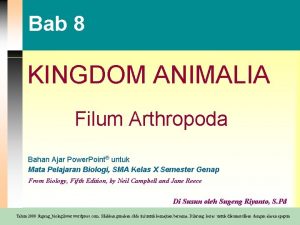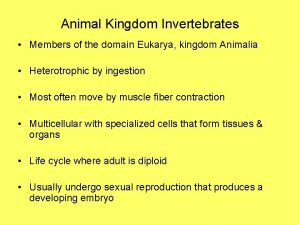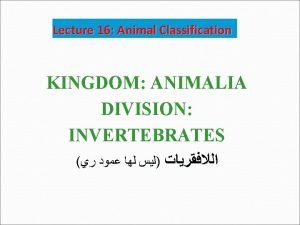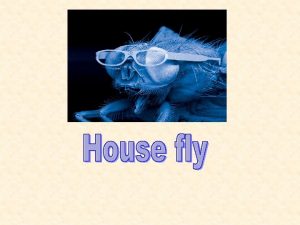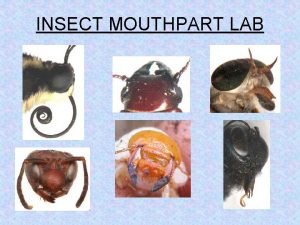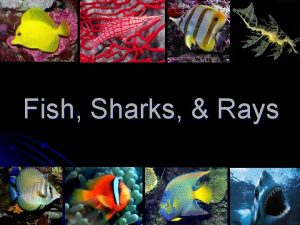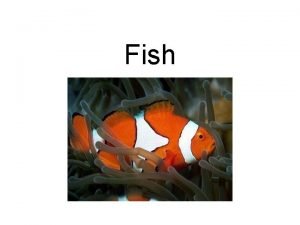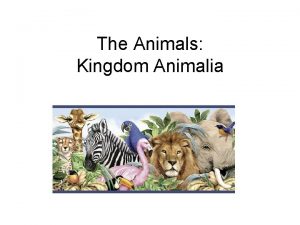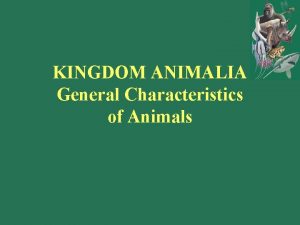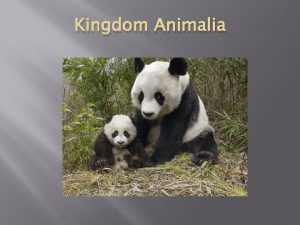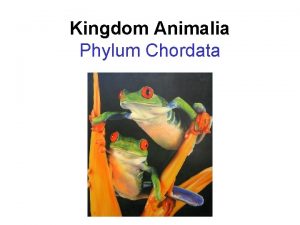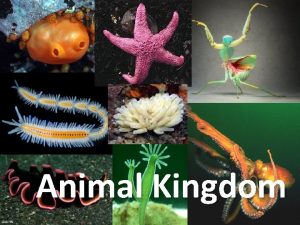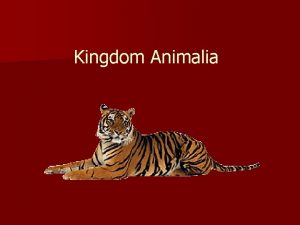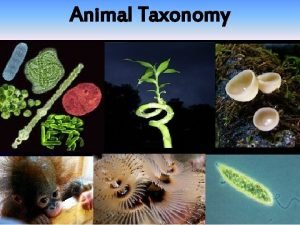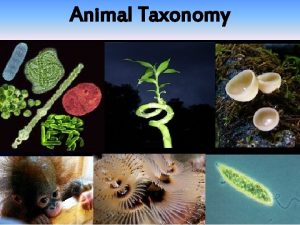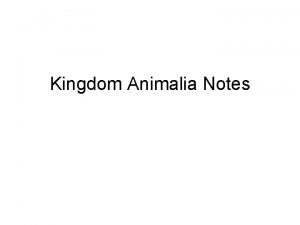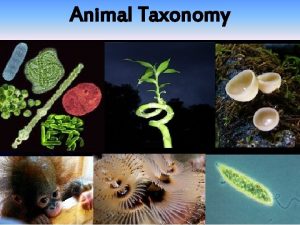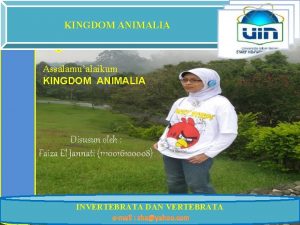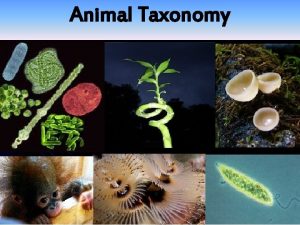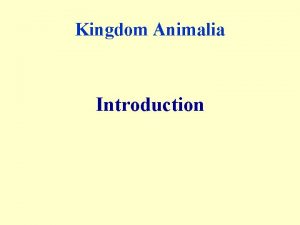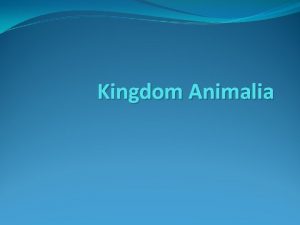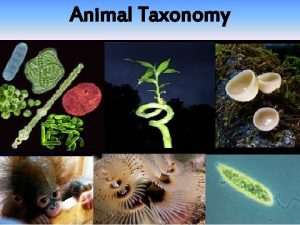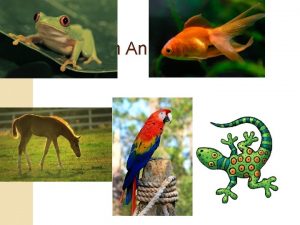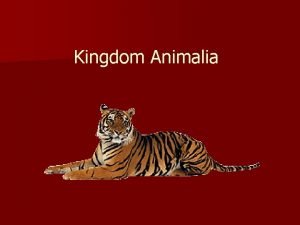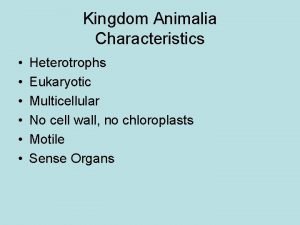Kingdom Animalia Characteristics of Animals Multicellular with complex


























- Slides: 26

Kingdom Animalia

Characteristics of Animals • Multicellular with complex systems • Symmetry – Sponges are asymmetrical – Most are bilateral or radial • Heterotrophic • Sexual reproduction – Some can also reproduce asexually

What is Symmetry? • Symmetry is how the body of the animal is organized • Radial means “circular” – The animal can be divided many directions through a central point to produce two equal sides • Bilateral means “two-sided” – The animal can be divided down the middle to produce mirror images

Animals that are bilateral have: • • • Anterior = front end (head) Posterior = tail end Lateral = side Dorsal = back side Ventral = belly side

Phylum Porifera • Common name: Sponges • Simplest of all animals • Asymmetry • 3 types of cells living in cooperation with each other • Fresh and salt water forms

Phylum Cnidaria • • Radial symmetry Stinging cells All are predators Fresh and salt water forms • Carried by the current

Phylum Mollusca • Soft bodied • Bilateral symmetry • Live in fresh & salt water or on land • Some have two shells – Clams, mussels • Some have one shell – snails • Some have no shell – Squid and octopus

Phylum Platyhelminthes • • • Flat worms Bilateral symmetry Fresh or salt water Some are parasites Very simple – Systems not well developed

Phylum Nematoda • Round worms • Many are microscopic and not much is known about them • Found in water, soil, and inside plants and animals • Some are important parasites of plants, animals, & people • Bilateral symmetry • Systems are not welldeveloped

Phylum Annelida • Segmented worms • Bilateral symmetry • Well-developed body systems • Marine, freshwater, and soil • A few are parasites

Phylum Arthropoda • • • Largest group of all animals Includes the insects, spiders, crabs, etc Bilateral symmetry Jointed appendages Well-developed body systems Found in fresh and salt water & on land


Phylum Chordata • • Most complex group of animals Bilateral symmetry Well-developed nervous system Must have a neural tube, a notochord, & gill slits during some point of development. – Some keep these features for their whole life.

Non-vertebrate Chordates • Tunicates – Filter-feeders – Related to vertebrates – Larva have all chordate characteristics, adults have neither a notochord nor a tail • Lancelets – Fish-like – Keep all chordate characteristics through life

Subphylum Vertebrata Most chordates are vertebrates Notochord becomes the vertebral column (backbone) Dorsal hollow nerve cord is protected by vertebrae Below is the current understanding of vertebrate evolution

Class Agnatha • Jawless fish • Cartilage skeleton • Lampreys are parasites of other fish and sperm whales • Larvae start in freshwater

Class Chondrichthyes • Cartilage fish – Sharks, skates, rays • Skeleton made of cartilage • Skin and teeth are made of same substance • 2 chambered heart • Ectothermic – Body temperature not regulated • Largest sharks and skates are filter feeders…why?

Class Osteichtheyes • • • Bony fishes Skeleton of bone 2 chambered heart Scales Gills

Class Osteichtheyes • • Bony fishes Skeleton of bone 2 chambered heart Scales Gills External fertilization Lay eggs, do not care for young

Class Osteichtheyes • • • Bony fishes Skeleton of bone 2 chambered heart Scales Gills External fertilization Lay eggs, do not care for young Ectothermic Most are ray-finned fishes-fins are slender bony spines connected by a thin layer of skin Most are either fresh or marine – a few move from salt to fresh and back again – sturgeons, salmon

Class Amphibia • Metamorphosis • Ectothermic • Fish-like larvae live in water – – Have gills Swim 2 chambered heart scavengers • Adults – Use lungs, skin, and mouth lining for gas exchange – Walk, hop, swim – 3 chambered heart – Predators – External fertilization – Lay eggs in water – No care of young

Class Reptilia • Ectothermic • Modified 4 chambered heart • Scaly, dry skin • Claws • Internal fertilization • Amniotic egg • No care of young • Examples: snakes, turtles, lizards, etc.

Crocodile (above) Frilled lizard Albino corn snake

Class Aves (Birds) • Endothermic • 4 chambered heart • Scales and feathers (modified scales) • • • Hollow bones Air sacs Internal fertilization Amniotic egg Care for young

Class Mammalia • • • Endothermic 4 chambered heart Hair Mammary glands Internal fertilization Live young (a few exceptions) • Care for young • Most intelligent class

Walrus (placental mammal) Kangaroo (marsupial) Duck-billed platypus-monotreme Killer whale (placental mammal)
 Mammals characteristics
Mammals characteristics Characteristics of animalia kingdom
Characteristics of animalia kingdom Characteristic of an animal
Characteristic of an animal Old kingdom middle kingdom new kingdom
Old kingdom middle kingdom new kingdom Nnn ruled
Nnn ruled Roman empire
Roman empire Capital of egypt during the old kingdom
Capital of egypt during the old kingdom Kingdom
Kingdom Characteristics of animal kingdom
Characteristics of animal kingdom Nine phyla of kingdom animalia
Nine phyla of kingdom animalia Kingdom animalia cell structure
Kingdom animalia cell structure Cladogram of the 6 kingdoms
Cladogram of the 6 kingdoms Lackcell
Lackcell Fish kingdom phylum class order
Fish kingdom phylum class order Monera protista fungi plantae animalia
Monera protista fungi plantae animalia Kingdom animalia phylum chordata
Kingdom animalia phylum chordata Ciri insecta
Ciri insecta Which are all members of the domain eukarya
Which are all members of the domain eukarya Protista plantae fungi and animalia
Protista plantae fungi and animalia Kingdom animalia
Kingdom animalia Family leporidae kingdom
Family leporidae kingdom Diptera
Diptera Animal classification domain
Animal classification domain Insect order classification
Insect order classification Animalia kingdom
Animalia kingdom Kingdom animalia fish
Kingdom animalia fish Sub kingdom of fish
Sub kingdom of fish
